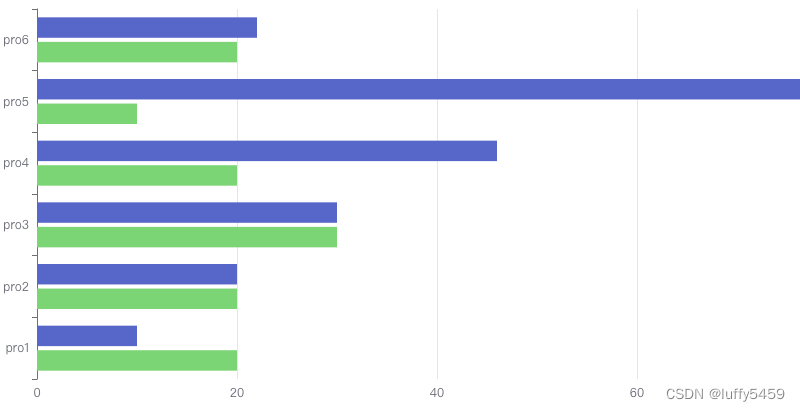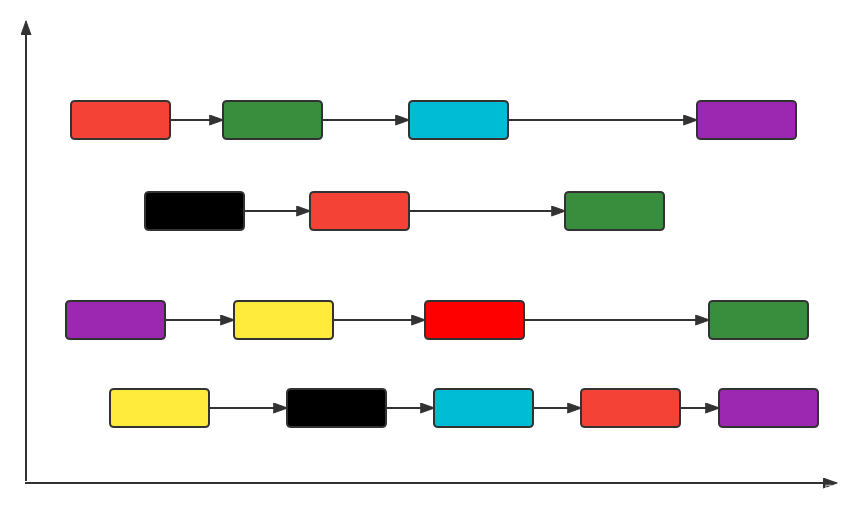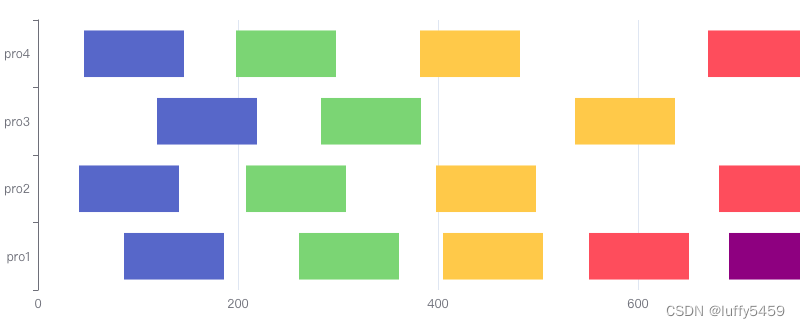Vue echarts画甘特图
luffy5459 人气:0vue项目中添加echarts,只需要增加echarts依赖,然后在main.js中引入echarts就可以使用了。
1、npm install echarts --save
2、修改main.js
import * as echarts from 'echarts' Vue.prototype.$echarts = echarts
3、具体页面使用:
<template>
<div class="about">
<h1>This is echarts page</h1>
<div id="myechart" style="height:500px;width:1000px;" ></div>
</div>
</template>
<script>
export default{
name:'MyEchart',
mounted(){
this.drawEchart()
},
methods:{
drawEchart(){
let myechart = this.$echarts.init(document.getElementById("myechart"))
myechart.setOption({
title:{text:"gant"},
xAxis:{
type:'value'
},
yAxis:{
type:'category',
data:["pro1","pro2","pro3","pro4","pro5","pro6"]
},
series:[
{
type:'bar',
data:[10,20,30,46,78,22]
}
]
})
}
}
}
</script>展示效果:

甘特图在这个图形的基础上还需要增加数据,形成一个不断迭代的效果。
{
type:'bar',
name:'base',
//stack:'Total',
data:[10,20,30,46,78,22]
},
{
type:'bar',
name:'data2',
//stack:'Total',
data:[20,20,30,20,10,20]
}如果不做设置,效果如下所示:

两组数据都从原始位置开始,我们想要的结果是叠加,这里只需要增加一个参数stack:'',指定一个相同的名称,效果如下:

我们如果不想展示第一段,只展示第二段,这时候可以设置第一个数据集对应的样式:
itemStyle{
borderColor:'transparent',
color:'transparent'
}展示效果:

我们最终需要的效果如下所示:

从上面的示例,我们可以这样来实现, 把两组数据看作一组,每一组第一个数据集展示隐藏,这里如果是项目进度图,我们可以把开始时间、结束时间作为一组,结束时间与开始时间中间这一段时间就是持续时间,这个时间在这里是一个增量,就是第二个数据集是展示在第一个数据集的基础上,它不能再直接使用结束时间,而是使用间隔时间。
数据集:
series:[
{
type:'bar',
name:'base',
stack:'Total',
data:[86,41,119,46],
itemStyle:{
borderColor:'transparent',
color:'transparent'
}
},
{
type:'bar',
name:'data2',
stack:'Total',
data:[100,100,100,100]
},
{
type:'bar',
name:'data3',
stack:'Total',
data:[75,67,64,52],
itemStyle:{
borderColor:'transparent',
color:'transparent'
}
},
{
type:'bar',
name:'data4',
stack:'Total',
data:[100,100,100,100]
},
{
type:'bar',
name:'data5',
stack:'Total',
data:[44,90,154,84],
itemStyle:{
borderColor:'transparent',
color:'transparent'
}
},
{
type:'bar',
name:'data6',
stack:'Total',
data:[100,100,100,100]
},
{
type:'bar',
name:'data7',
stack:'Total',
data:[46,183,'-',188],
itemStyle:{
borderColor:'transparent',
color:'transparent'
}
},
{
type:'bar',
name:'data8',
stack:'Total',
data:[100,100,'-',100]
},
{
type:'bar',
name:'data9',
stack:'Total',
data:[40,'-','-','-'],
itemStyle:{
borderColor:'transparent',
color:'transparent'
}
},
{
type:'bar',
name:'data8',
stack:'Total',
data:[{value:100,itemStyle:{normal:{color:'purple'}}},'-','-','-']
}
]最终的一个效果:

这个里面,对应每一个数据项都可以设置显示颜色,具体操作就是把data:[]数组变更为:
data:[
{
value:100,
itemStyle:
{
normal:
{color:'purple'}
}
},
'-',
'-',
'-']原来的数据项,变为一个对象,对象的值value对应原来的数字值,样式则使用itemStyle属性设置。
甘特图绘制需要注意的地方:
1、数据显示叠加,使用属性stack。
2、隐藏开始时间,设置显示透明即可。结束时间点不能直接设置结束时间,这是一个增量,需要设置时间间隔。
3、每一个数据项展示,可以单独设置样式,比如颜色,可以把data数组做修改,原来单一的数字值,修改为对象,包含value,itemStyle等属性。
加载全部内容